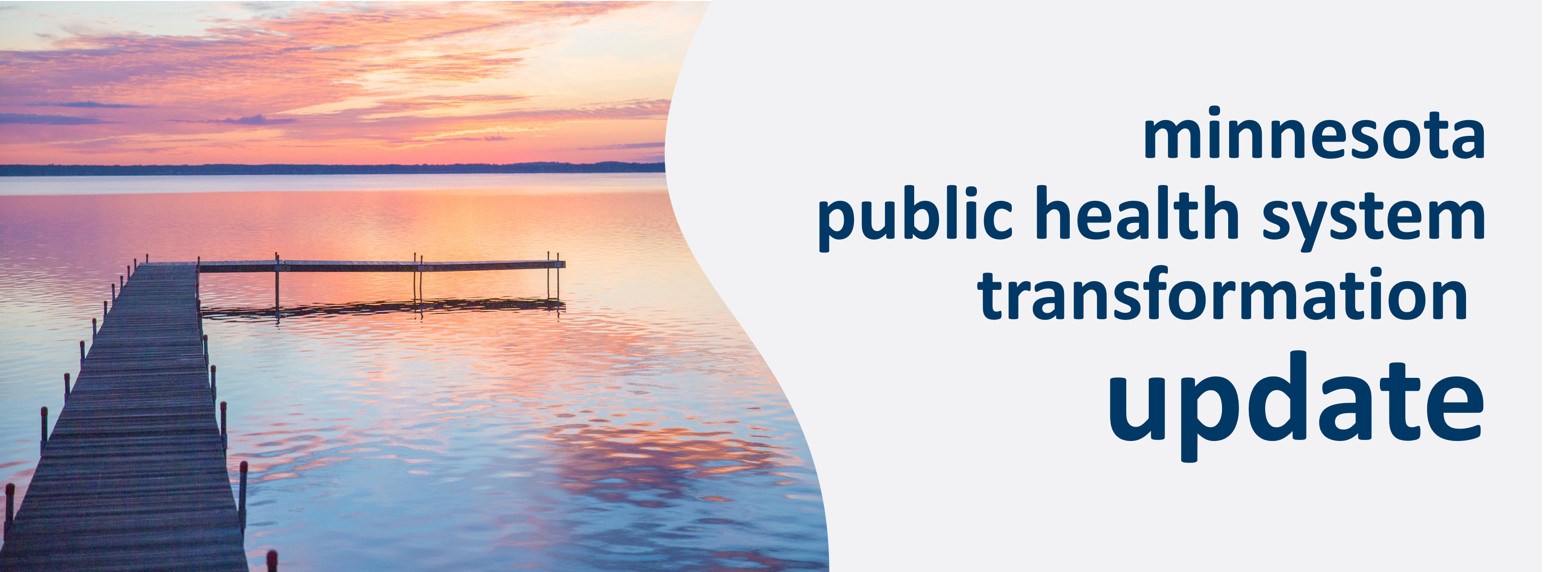Transforming Minnesota's Public Health System
- Home: System Transformation
- About This Work
- Framework of Foundational Responsibilities
- Definitions, Criteria, and Standards for Fulfillment
- Joint Leadership Team
- Minn. Infrastructure Fund and Local Innovation Projects
- Governance Groups and Communities of Practice
- Data Modernization
- Regional Data Models
- Tribal Public Health Capacity and Infrastructure
- FPHR Grant: Funding for Foundational Responsibilities
- Reports, Fact Sheets, Resources
- Newsletter
- Message Toolkit
Related Sites
Contact Info

Public Health System Transformation Update Newsletter
April 2025 | View all system transformation newsletters
How can you help people understand the role and value of public health? Try these steps
It’s hard to cut through the noise and build communications that stick, while also centering prevention, population health, and equity. Read on for some concrete steps to create messages that work:
- First, start with a shared goal and shared values
- Next, use this formula before digging into the data:
Value + People + Goal + Problem + Solution - Finally, bring your work to life with stories and data
1. First, start with a shared goal and shared values
If we want our messages to stick, research overwhelmingly shows we should ground our public health communications and talking points in shared values and common goals.
Consider this excerpt from the introduction to a recent report to the Minnesota Legislature from the Joint Leadership Team for System Transformation, which discusses "why" of public health as much as the "what":

Minnesota’s quality of life depends on thriving, vibrant communities. Where we live provides the building blocks for long-term health and wellbeing, including protection from the spread of infectious diseases and environmental threats, clean water, strong schools, sustaining jobs, community connectedness, access to health care, and other important community support.
In public health, we work to change these surroundings for the better so that it’s easier for all of us in Minnesota to be our healthiest no matter who we are or where we live.
– Introduction, Public Health System Development in Minnesota (Report to the Legislature, Jan. 2025) (PDF)
When we start from a common goal or shared values, we’re letting the person or group we’re talking to know that we’re in it together—public health is here to help.
The values and goals you share depend on who you’re talking to, and are different for each group or person; one size won’t fit all.
2. Next, use this formula before digging into the data
Try using these five points in any order to introduce or reintroduce or your public health work to someone—no matter how many times you’ve already met:
Value + People + Goal + Problem + Solution

Value
To describe the role and value of public health:
There's nothing public health can't positively impact. Public health workers partner with their communities to overcome all types of barriers people face to living their healthiest lives.
(Share a few one/two-word examples that your listener understands, like clean drinking water, smoke-free restaurants, or healthy babies.)

People
To describe the people who improve Minnesota's public health:
We're a community of experts and leaders. Public health workers, elected officials, and community members are proud of the work they do to keep Minnesotans healthy.

Goal
To emphasize the shared goal we're all working toward:
We want to help all Minnesotans live their healthiest lives. Everyone in Minnesota should have the opportunity to be healthy, no matter who they are or where they live.

Problem
To show what's keeping us from doing our best work, and the consequences it has on Minnesotans:
Minnesota's approaches are out of date. Minnesota’s approach to public health was designed more than 50 years ago and doesn’t meet today’s funding and resource challenges.
(Is there another problem you’d like your listener to help you solve? Substitute it here.)

Solution
To explain how an updated approach will help both you and your listener meet your shared goals and/or honor your shared values:
We need to invest in a new approach. It’s time to invest in a new approach that embraces fair funding and creative collaboration to meet today’s complex needs.
(Is there a different solution you’re proposing to solve the problem you just noted? Substitute it here.)
3. Finally, bring your work to life with stories and data
After you introduce your issue or work, then tell stories that bring your message to life, and share data or proof points that support your message.
- Stories/examples help your audience feel like they’re “in the river” too, creating a thriving community with you, and will often stick with audiences long after they forget data points. “I could tell you about the river, or we could just get in.” – Bill Callahan, singer-songwriter
- Data can help show the return on investment of public health work, or make public health's reach clear and show the value of cooperation.
Learn more
- Use Minnesota's framing toolkit: For research-based, values-driven communications tips and tricks developed specifically for Minnesota, visit: Message Toolkit: Inspiring Partners to Strengthen Public Health in Minnesota.
- Schedule a workshop: To schedule a workshop for your health department or division on how to use this toolkit and framework, contact the MDH Center for Public Health Practice: health.ophp@state.mn.us. At this time, workshops are open to local and Tribal health departments in Minnesota and to MDH staff.
- Keep reading: You can find more resources for yourself and your communications staff online, to help build clear, consistent communications no matter where you are: Public Health System Transformation Update Newsletter: What's on our radar in April 2025?